“], “filter”: “nextExceptions”: “img, blockquote, div”, “nextContainsExceptions”: “img, blockquote, a.btn, a.o-button” }”>
Heading out the door? Read this article on the new Outside+ app available now on iOS devices for members!
>”,”name”:”in-content-cta”,”type”:”link”}}”>Download the app.
Prenatal yoga classes are all about preparing the body for expansion. But what about the coming back together that is necessary after giving birth?
The pelvic region undergoes significant changes from pregnancy to birth. From conception to full term, the pelvis expands to accommodate the growing uterus and, eventually, a baby. The pelvic bowl also changes shape multiple times during the labor process alone.
“When baby moves lower into the pelvis to prepare for birth, the pelvic joints can contract, expand, rotate, and even separate,” explains Kimberly McFerron, chief experience officer for the women’s telehealth company Ruth Health. This is true even if the delivery is via Cesarean section.
These changes are possible due to the pregnancy-specific hormone relaxin, which loosens connective tissue and joints throughout the body. But the production of relaxin does not stop immediately after birth. McFerron cautions her patients that their bodies can continue to release the hormone at a fairly high concentrations postpartum. If someone chooses to breastfeed, the body may continue to produce relaxin throughout the nursing period.
But as yoga can help prepare the body for birthing a new life, it can also help restore it afterward. Just keep in mind that the pieces may fit a little differently.
How Postnatal Yoga Can Help Pelvic Stability
Minimize Deep Squat Positions
McFerron generally recommends that anyone wanting to restabilize the pelvis postpartum avoid yoga poses that encourage more pelvic opening or flexibility. That includes deep squat positions, such as Malasana (Squat), and end-range external rotation poses, such as Eka Pada Rajakapotasana (Pigeon Pose), both of which tend to be practiced quite heavily in prenatal classes.
Target the Deep Core
Instead, many postnatal fitness experts encourage postpartum people to choose yoga poses and workouts that focus on core-stabilizing postures, such as Tabletop with the toes tucked and the knees lifted or with opposite arm and leg extended. Certified personal trainer Megan Martineau, who offers prenatal and postnatal movement tutorials on TikTok, suggests that post-birth practices instead focus on the “deep core, such as the transverse abdominis, pelvic floor, and glute muscles.”
Movements that target that musculature include hip adduction postures, such as squeezing a block between your legs in Utkatasana (Chair Pose) and poses that keep the spine stable as the limbs move, such as like Urdhva Hastasana (Upward Salute or Arms Overhead in Mountain Pose).
(Moderately) Engage the Glutes
While there is some disagreement among yoga teachers over whether we should “grip” our gluteus maximus during backbends, the glutes reflexively engage with hip extension, making this category of poses a reliable way to access that muscle group.
There’s another benefit of returning to yoga practice after birth. Although the stability that new parents often seek is in the physical body, the practice also provides emotional support during early parenthood. Although contemporary “bounce back after birth” culture tends to emphasize more of what’s happening on the outside, postnatal movement experts encourage new parents to focus more on what they are feeling versus how things may look.
Consult with your healthcare provider before engaging in any physical activity.

5 Postnatal Yoga Poses to Help Improve Pelvic Instability
1. Virasana (Hero’s Pose)
In any movement practice, the very first thing you want to do is establish your breath. This is especially true postpartum, when your breathing patterns and pelvic floor have been compromised by birth trauma. Postnatal care providers often emphasize contracting the pelvic floor post-birth with Kegel exercises, but these can be overdone and lead to even more pelvic dysfunction. Learning how to relax the pelvic floor on an inhalation is equally important.
Sitting on a block in a Virasana shape can help you feel what is happening in your pelvis when you are breathing. The pose establishes neutral alignment because it balances the pelvic bowl in all three planes: front/back, side/side, and rotationally.
How to: Bring your knees together and your ankles hip-distance apart or wider. Place a block or rolled blanket between your ankles for support. (You’ll want to start a little higher than you usually would so that you can feel your sit bones.) Lower your seat onto the props and align your pelvis so that it’s level on all four sides. Feel free to use your hands as a leveler. Stack your head, shoulders, and rib cage directly above the pelvis in a neutral spine. Rest your hands on your thighs and close your eyes.
Take 10 deep breaths. As you inhale, observe how your sit bones naturally spread and the pelvic floor softens. Your pelvis may even tip forward slightly, arching your lower back. As you exhale, your sit bones will draw toward one another and your pelvic floor will engage. Your pelvis may curl under slightly but there is no need to force any movement or engagement. Simply breathe and observe the natural movements of your body.
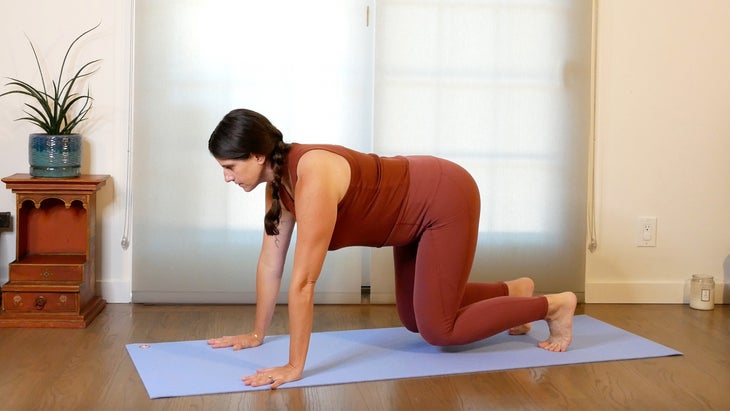
2. Hovering Tabletop Variation
The transversus abdominis is our deepest core muscle and a key player in stabilizing our pelvis and spine. It can be accessed simply through deep breathing when our spine is neutral. Hovering the knees off the floor can be a great way to strengthen it.
Since we’re on all fours for this position, the sit bones are now in space, unlike in the previous pose, and it can be harder to get a read of what is happening down there. In this variation, you will be bringing your thighs toward one another, while keeping your feet hip-width (employing adduction and internal rotation at the hip). This position gives you more feedback on how the pelvic floor is moving with your breath.
How to: Come onto hands and knees. Place your wrists under your shoulders and your knees below your hips. Keep your feet where they are as you bring your knees as close together as you comfortably can. They may touch or there may be a gap. Ensure that your shins and feet are wider than your knees and thighs. Curl your toes under and take one full breath here. See if you can reconnect to the natural pelvic movements you felt while sitting on a block.
On an exhalation, press your hands down and lift your shins and knees a couple inches off the mat. Try to keep your thighs aligned in your starting position. This will require a strong internal rotation action from your upper legs. Maintain a neutral spine as best you can by trying to lengthen from your crown to your tailbone. Look straight down between your hands. Remember, you want to allow the sit bones to expand as you inhale by relaxing the pelvic floor and then gently come together as you exhale with a gentle contraction. Hover for 3-5 breaths. Lower your knees to the mat and pause before repeating. You are rebuilding strength, so start with a shorter hold and strong alignment and then build up to longer holds.
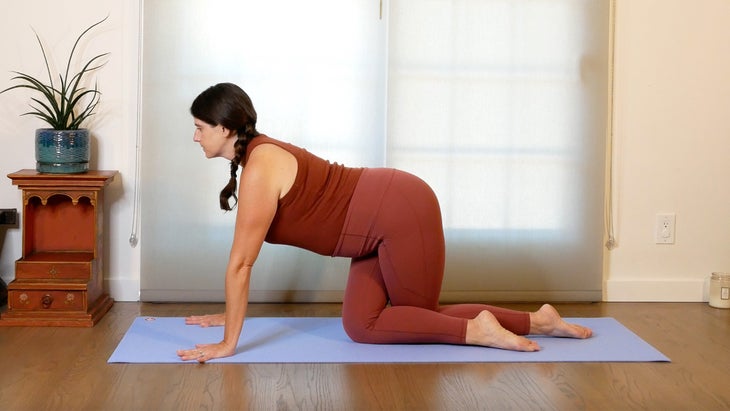
3. Cat-Cow Variation
As your uterus expands during pregnancy, your posture changes. Many parents end up with an exaggerated arch, or anterior tilt (sticking your bum out) during pregnancy. But following birth, you tend to sit more frequently because you are feeding the baby and recovering from birth, so you spend more time in a posterior tilt (tucking your bum under), creating the opposite pelvic pattern. Moving the pelvis through both extremes of front and back, or the sagittal plane, helps you notice which position you may be favoring. Having your thighs crossed in Gomukhasana (Cow Face Pose) provides an extra release for your outer hips while also strengthening your inner thighs.
How to: From hands and knees, cross your right knee in front of your left knee. You may need to make some adjustments, such as lifting your front knee or walking your hands further forward than your shoulders. Start to move your spine any way that feels comfortable. Then, as you inhale, lift your chest toward the wall in front of you and arch your spine, spreading your sit bones and imagine your pelvic floor softening.
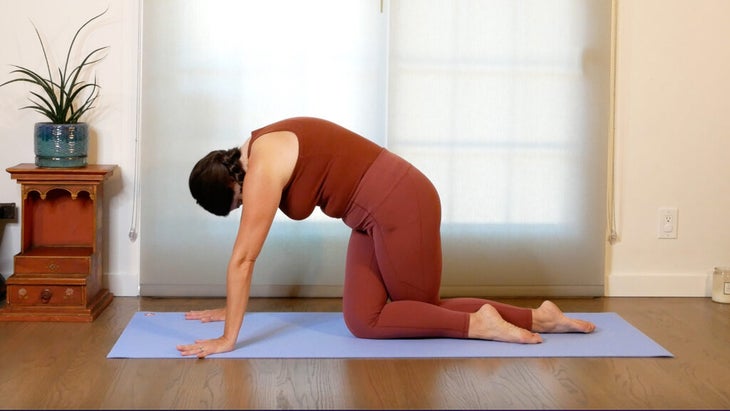
As you exhale, press your hands into the mat and round your back, draw your sit bones underneath you, and contract your pelvic floor. That was one full round. Repeat for a total of 5 rounds. Uncross your thighs, come back through hands and knees, and repeat with your left knee in front of your right leg.
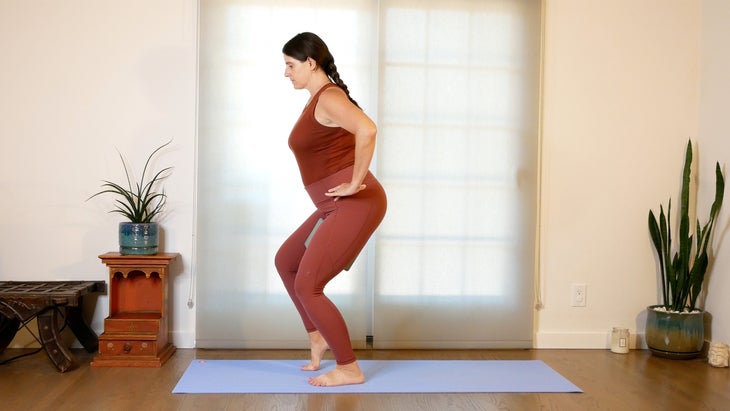
4. Utkatasana (Chair Pose) Variation
This variation of Chair Pose teaches pelvic stability in the coronal plane, which is all about side bending and lengthening. Hugging a block between your legs creates an awareness and imprint of where and how the midline of our body, namely the inner thighs and spine, is moving.
How to: Stand at the top of your mat in Tadasana (Mountain Pose). Take your feet apart and place a block between your inner thighs just above your knees. Adjust the block setting to be as wide or narrow as you need to feel stable in your feet and spacious in your lower back.
Place your hands on your hip bones. As you exhale, bend your knees and shift your bum back into Chair Pose. Using your hands for feedback, level your pelvis so one hip isn’t higher than the other. Keeping your knees bent, lift onto your right tippy toes without lifting your pelvis on that side. Slowly lower your right heel to the mat and switch sides. Go back and forth a few times. With practice, you may extend your arms alongside your ears and practice stabilizing your pelvis side to side by muscle memory alone rather than using your hands. After 5 full rounds, straighten your legs. Feel free to repeat.
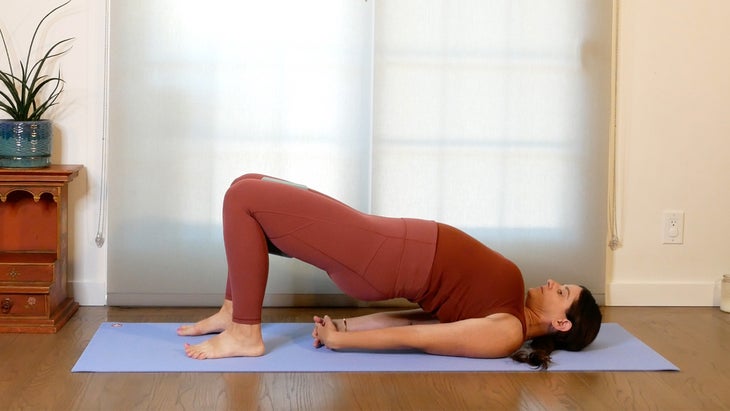
5. Setu Bandha Sarvangasana (Bridge Pose) variation
Montreal-based yoga teacher Nancy Zagbayou teaches “controlling and toning the pelvic floor” in her postnatal yoga classes through mula bandha awareness. Like most subtle body concepts, there is no exact anatomical location for what in English is known as the root lock. However, it is said to be accessed through the perineum, located in between the pubic bone and tailbone. Zagbayou believes accessing mula bandha to be one of the more important “rehabilitative” aspects of postnatal yoga classes. Placing a block between the thighs in Bridge Pose can be a good way to ignite Mula Bandha. Lifting one leg at a time also strengthens your outer glutes as they work to stabilize the pelvis rotationally in the transverse plane.
How to: Come onto your back. Place a block in between your inner thighs just above your knees. Position your feet hip-width apart on the mat. Try to keep the block stable by gently hugging your inner thighs toward one another as you set up for Bridge Pose. As you inhale, lift your hips and draw your upper arms underneath you. Interlace your fingers or hold the edges of the mat. Take 5 full breaths here and simply observe your pelvis as you breathe.
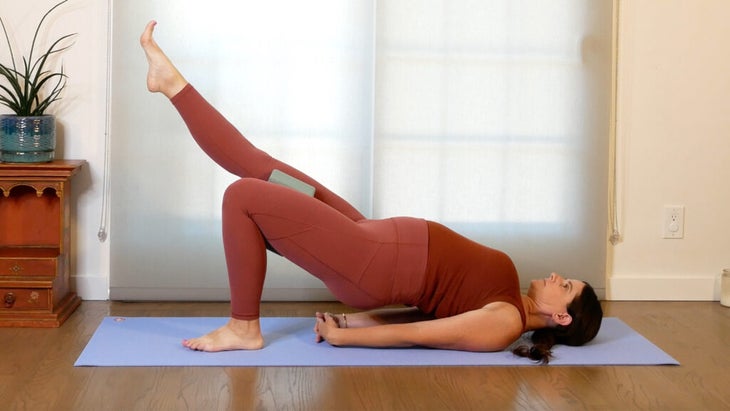
Bring more weight into your left foot and slowly straighten your right leg toward the front of the mat. Keep your thighs parallel. The pelvis tends to rotate toward the lifted leg. Use your block for feedback to keep the right side of your pelvis lifted. Take 5 full breaths. Return your foot to the mat and lower yourself completely. Pause for a moment before repeating on your left side.
About Our Contributor
Sarah Ezrin is a mama, a world-renowned yoga educator, a popular Instagram influencer, and the author of The Yoga of Parenting. Her willingness to be unabashedly honest and vulnerable along with her innate wisdom make her writing, yoga classes, and social media great sources of healing and inner peace for many people. Based in the San Francisco Bay Area, Sarah is changing the world, teaching self-love one person at a time. You can follow her on Instagram at @sarahezrinyoga and TikTok at @sarahezrin.


